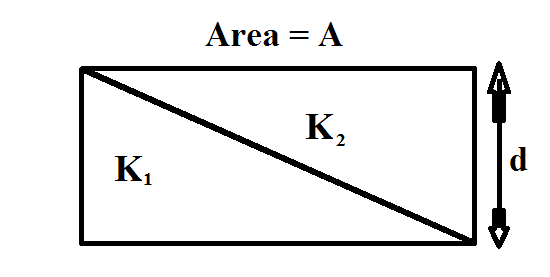Equivalent capacitance
The capacitance of a parallel plate capacitor with plate area A and separation d, is C in vacuum .The space between the plates is filled with two wedges of dielectric constant and respectively . Find the capacitance of the resulting capacitor in

The answer is 9.162907319.
This section requires Javascript.
You are seeing this because something didn't load right. We suggest you, (a) try
refreshing the page, (b) enabling javascript if it is disabled on your browser and,
finally, (c)
loading the
non-javascript version of this page
. We're sorry about the hassle.
According to the figure The right vaccum place is filled by dielectric constant K 1 & the left above vaccum by dielectric constant K 2
Let us consider the capacitance of the slab whose width is 'b' & length 'dx & seperation 'y' be d C 1 & the above slab whose separation is (d-y) be d C 2 .
Now Area of the those two slabs is = b . d x
d C 1 = y ϵ 0 A K 1
d C 2 = d − y ϵ 0 A K 2
Since they are connceted in series we have their equivalent capacitance dC
d C 1 1 + d C 2 1 = d C 1
d C 1 = ϵ 0 A 1 ( K 1 y + K 2 d − y )
d C 1 = ϵ 0 A K 1 K 2 1 ( d K 1 + y ( K 2 − K 1 ) )
d C = ( d K 1 + y ( K 2 − K 1 ) ) ϵ 0 A K 1 K 2
So the entire capacitance over length ’l’ is given by :
C = ∫ 0 l ( d K 1 + y ( K 2 − K 1 ) ) ϵ 0 A K 1 K 2
We have from figure that A = b . d x & t a n θ = x y = l d ⟹ y = x l d
C = ∫ 0 l ( d K 1 + x l d ( K 2 − K 1 ) ) ϵ 0 b K 1 K 2 d x
C = ∫ 0 l d ( K 1 l + x ( K 2 − K 1 ) ) ϵ 0 b K 1 K 2 l d x
C = d ϵ 0 b K 1 K 2 l ∫ 0 l ( K 1 l + x ( K 2 − K 1 ) ) 1 d x
C = d ϵ 0 b K 1 K 2 l K 2 − K 1 1 ( l o g ∣ K 1 l + x ( K 2 − K 1 ) ∣ ) 0 l
C = d ϵ 0 b K 1 K 2 l K 2 − K 1 1 ( l o g ∣ K 1 K 2 ∣ )
C = d ( K 2 − K 1 ) ϵ 0 b K 1 K 2 l ( l o g ∣ K 1 K 2 ∣ )
C = d ( K 2 − K 1 ) ϵ 0 A K 1 K 2 ( l o g ∣ K 1 K 2 ∣ )
The final capacitance is C & putting values thus provided we derive C = 9 . 1 6 3